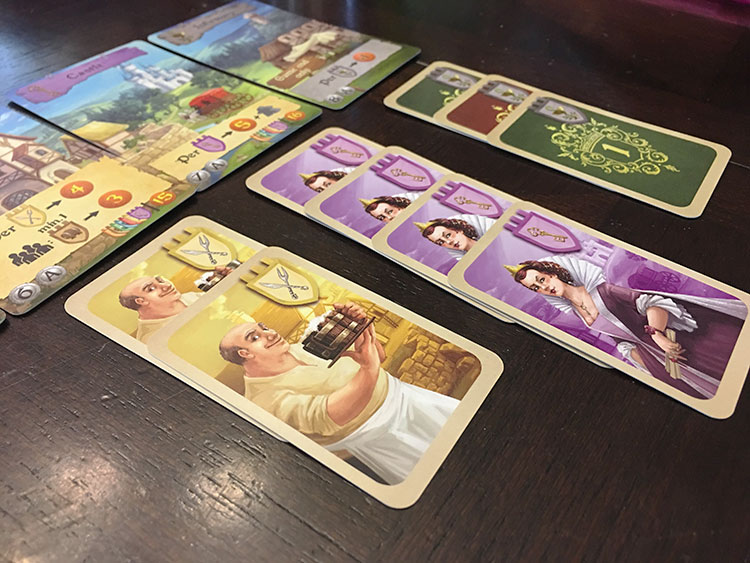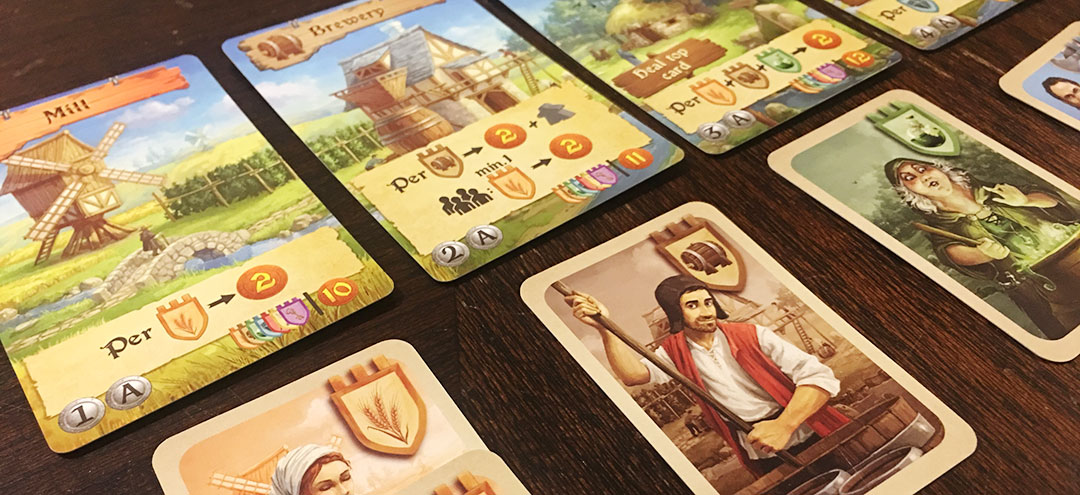 In 2014, Marc Andre made a huge splash in the gaming industry with Splendor, which received critical acclaim, a slew of awards nominations, and became a top choice for families and introducing new gamers to the hobby. With Majesty: For the Realm, Andre provides another offering for a light game with a very low barrier for entry. Does Majesty bring wealth and prestige to the board gaming realm? Read ahead to find out.
In 2014, Marc Andre made a huge splash in the gaming industry with Splendor, which received critical acclaim, a slew of awards nominations, and became a top choice for families and introducing new gamers to the hobby. With Majesty: For the Realm, Andre provides another offering for a light game with a very low barrier for entry. Does Majesty bring wealth and prestige to the board gaming realm? Read ahead to find out.
Majesty: For the Realm is a drafting and set collection game for 2-4 players. Majesty plays best with 3-4 players.
Gameplay Overview:
Each player starts with an identical set of 8 locations in combinations that can vary from game to game. The locations each correspond to a character type, such as witches, millers, or nobility, and are activated whenever that character type is drafted by a player. Locations usually provide points to players based on the numbers and combinations of various characters. For instance, the Mill awards two points per miller a player has when it’s activated, while the Cottage awards two points per brewer, witch, and guard a player has in their layout. Some location powers provide points to any player with a particular character, and some have special abilities like attacking your opponents, protecting you from attack, or healing your wounded.

On a player’s turn, they select a character from the layout, with the first in line free, and every one after requiring a villager to be placed on preceding cards (i.e. if the knight at position 4 is drafted, a villager is placed on the first three cards.) Each player has 5 villagers to start, but can earn more via picking characters with villagers present on it, and through location powers. The player places their drafted character under the corresponding location, activating and resolving location effects. Players return any villagers in excess of 5 back to the supply, scoring a victory point for each one returned, then play proceeds to the next player.
Play ends when all players play 12 character cards. Bonus points are awarded for having a majority of type of character and for having a variety of characters. In the end, the player with the most victory points is declared the winner!

Game Experience:
The main appeal of Majesty: For the Realm is its ease of access in terms of rules and gameplay. From unboxing to the start of play takes a short amount of time, and the game is forgiving and not especially harsh on beginners to punish sub-optimal play. However, there can be a good amount of number-crunching and mental math as the endgame approaches, determining which character selection will maximize point totals based on which location is activated. There is enough of a game here to satisfy both the casual and the analysis-paralysis player.

While some may be critical that Majesty involves only 12 choices from a player per game, we feel that it fits into the game’s overall mission of providing a quick and easy game. In all of our plays, from two to four players, no game lasted longer than 30 minutes. Even with some players prone to getting stuck in their mental mathematical gymnastics, there was no real downtime for players, keeping the pace of play rapid.
An aspect of Majesty that sets it apart is that there is a surprising amount of player interaction. It would be easy for this game to turn into a ‘multiplayer solitaire’ but there is always a need to keep awareness of your opponents layouts due to the possibilities of attacking and defending as consequences of selecting particular characters. Since final scoring depends on having a majority of each character, making sure you are thinking about not only your actions but drafting to stymie opponents needs to be factored into each turn.
For all of its mechanical elegance, Majesty falls short in the area of thematic expression during gameplay. While the art and graphic design are very pleasing and support the medieval era theme, the game could be set on an alien world, or inside a computer system, or in a bevy of other eras and settings. It suffers from the same problem a title like Dominion has – a generic theme that is just there for art & naming powers.

While we enjoyed the game with two players, in our plays we found that playing with at least three is best. Because of the game’s majority-rules scoring at the end, we found that three players added extra strategy to drafting, while with two players the majority rule ended up being almost too balance. In plays with 2 players, our final scores were within 5 points in every game we played, while there was greater variation in our plays with three & four.
Marc Andre is the designer of both this title and Splendor, and there has been quite a bit of digital space devoted to the comparison of the two. We disagree with the assertion that Majesty is a ‘Splendor replacement,’ as they are two different games with completely different mechanics and gameplay. Where the games differ is that we feel Majesty has a (slightly) deeper strategy level than Splendor, even though it still stays at what we would consider a rules-light game.
Final Thoughts:
Majesty: For the Realm delivers on its promise of a straightforward and light drafting game. It provides enough depth and strategic choice to provide the heavy gamers with some satisfaction, while light enough to introduce non-gamers to the hobby. Majesty can also fit the bill for a great game to play with children and families looking for accessible medieval theme.
Final Score: 4 Stars – Solid and enjoyable. It’s definitely worth seeking out a play or your own copy.
 Hits:
Hits:
• Accessible rules and gameplay mechanics
• Good depth in drafting decisions
• Surprising level of player interaction
Misses:
• Pasted on theme
• Not good with two players























30 plays in Splendor I can destroy 4 times out of 5 anyone who played it less than 20 times.
I’m not sure I can say the same for this game.